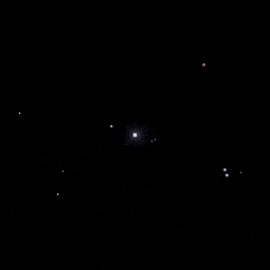 First 4 seconds after the collapse of WR1 in roughly real time
First 4 seconds after the collapse of WR1 in roughly real time
Fallen Star Incident Report
The Fallen Star Incident was the result of a gamma-ray burst (GRB) from the star NGC 592-WR1, which severely affected the atmosphere and biosphere of Selviytyä, requiring mass evacuations from the planet.
Background
WR1 was a Wolf-rayet star situated in the NGC 592 nebula cloud. It had a stellar classification of WNL, and a subclass of WN7. Its surface temperature was around 57,000 K and had a mass of rougly 22 solar masses. Prior observation showed that WR1's rotation axis was not aligned with Selviytyä, posing little risk to it.
Timeline of events
T- 47 hrs: WR1's rotational axis was roughly 27° away from the Aurinko System, making it a low risk star, as the widest GRB jet possible is less than 20°. However, observations showed its rotational axis became highly unstable and lowered from 27° to less than 10° over the span of several hours. The Stellar Warning Center (SWC) was notified of the percularities at this time, however no warning was announced yet.
T- 36 hrs: WR1's rotational axis appeared to be stabilizing at about 7.6° away from the Aurinko System, with its risk factor now at 78% compared to its previous 5.2%. Several brightening and dimming events were observed on WR1, showing signs of imminent collapse, warnings from the SWC were therefore given to worldwide governments.
T- 24 hrs: A bright flash was observed from WR1, likely a highly energetic starquake. Evacuation warnings were brodcasted worldwide.
T- 7 hrs: Several radio wave pulses and visible flashes were observed coming from WR1, which were also increasing in intensity.
 First 4 seconds after the collapse of WR1 in roughly real time
First 4 seconds after the collapse of WR1 in roughly real time
T 0: WR1 collapses, forming a GRB about 17.7° wide, making the Aurinko System within the hazard zone. Roughly 37% of the entire population of Selviytyä was evacuated at this point.
T+ 20 mins: The GRB beam hits the Aurinko System, causing a rise in nitrogen oxide levels in Selviytyä's atmosphere. Ozone levels started dropping due to the nitrogen oxide, exposing the surface to more UV radiation. Electromagnetic radiation was not increased by significant levels as the atmosphere blocks most of these kinds of radiation.
T+ 24 hrs: Ozone levels have plummeted by about 15% on average, with an increase in smog due to the nitrogen oxides. 67% of the population has been evacuated.
T+ 7 days: Global temperatures have decreased by about 2°C due to the smog, which also caused massive plant dieout due to lower photosynthesis capabilites. Most of the population have been evacuated by this point.
